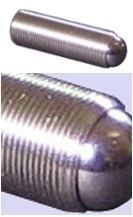 | ||
The term fine adjustment screw typically refers to screws with threads from 40-100 TPI (Threads Per Inch) (0.5mm to 0.2mm pitch) and ultra fine adjustment screw has been used to refer to 100-508 TPI (0.2 mm to 0.05 mm pitch). Even though these are non-standard threads, both ISO metric screw thread designations and UNC designations have been used to call out thread dimensions and fit (class). A typical use for a fine adjustment screw is in an optical mirror mount as an adjuster. Typically 80 TPI screws are used in mirror mounts. Ultra fine adjuster screws are used in applications requiring extremely fine motion like laser alignment, fiber coupling.
Contents
Fine and ultra fine adjustment screws are often used in photonics applications as part of purchased equipment (i.e. mirror mounts) or built into lab made (home built) apparatus. Often, screws are purchased with matching bushings to be integrated into an experiment or commercial product once attained. Fine adjustment screws and mirror mounts are available as standard items from most companies that sell optics hardware.
Explanation
The fine motion can most easily be calculated by using the pitch or TPI to determine how many micrometres per revolution the screw moves. The table below shows some common examples
The screw turns 360° in one revolution and with well made screws (minimal stiction) and a user with a sensitive touch, 1° movements can be achieved. Thus, with the ultra fine adjusters sub-micrometre motions are attainable.
Screws
The material of choice for producing these screws is stainless steel typically 18-8 (303). At the tip of the screw most commonly a stainless steel ball is either pressed or glued into place to provide a single point contact for the surface being moved. Common usage has shown the glue method of attaching the ball to be troublesome in many applications as some commonly used glues (Super Glue) tend to outgas and degrade over time in this application.
Nut/bushing
Each screw requires a nut/bushing which is critical in not only the length and class of the nut/busing but also the material itself. In low cost adjusters where grease can be used and wear and load is small, brass is typically the most economical material to use. In High-end adjusters where tight tolerances are required as well as the capability to withstand wear and higher load, phosphor bronze is the preferred material. Phosphor bronze is considered a self-lubricating material that makes it ideal for grease free applications e.g. vacuum. Still, the use of grease will extend the lifetime of the nut/bushing and is recommended unless a grease free version is required.
Finer adjusters
It is difficult to make screw threads finer than about 250 TPI. As of 2015 only a small handful of companies have the ability to consistently construct threads this fine. For applications that require still finer control, other solutions have been introduced:
